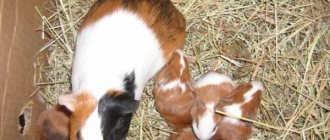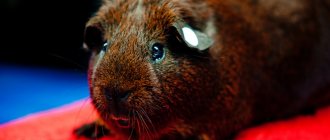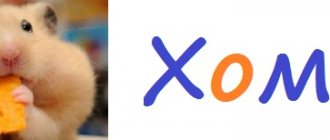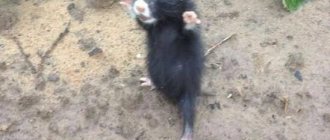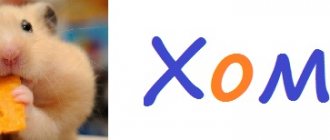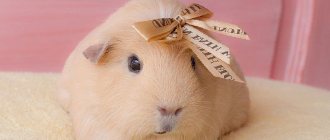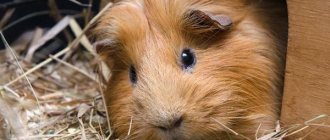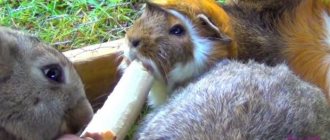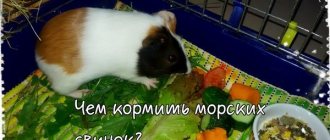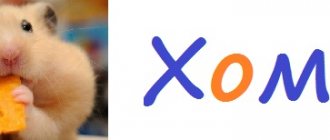- home
- Guinea pig
- General information about guinea pigs
02/11/2019 For many people, guinea pigs are charming pets; they often become full-fledged family members for their owner. But few people think about how these rodents live in natural conditions. Wild guinea pigs, of course, have different living conditions - no one cares for them or cares for them. These animals can only rely on themselves - they look for food themselves, arrange their homes themselves, and defend themselves from enemies. The characteristics of undomesticated guinea pigs and their living conditions will be discussed in this article.
Natural habitat, climatic conditions
The homeland of guinea pigs is South America, or more precisely, the countries of Chile and Peru. There they are called Kawii, this is a general name that includes different subspecies. Residents ate the meat of these rodents as food, since there were quite a lot of them. From South America, kui were brought to Europe. There the Germans gave their name to these animals. Since the animals look like mini-pigs, they were called pigs. And it is marine because it was brought from overseas. The Poles adopted the name from the Germans, and from the Poles the name passed to the Russian people.
Guinea pigs now live in almost the entire northern part of South America. They have adapted to rocky and sandy areas, savannah, and forested hills. In nature, guinea pigs live in Colombian swamps, as well as in northern Argentina and southern Brazil.
National dish of Peru
Baked or fried guinea pig is a national treat in Peru. The dish is called “kui”. It is prepared on holidays, for guests or just as part of a regular dinner. It all depends on the side dish and sauces served. Before cooking a guinea pig, the animal's carcass is thoroughly washed, rubbed with spices and left in a cool place for an hour or two.
To prepare you need:
Mix flour with salt (half a teaspoon). Dissolve one tablespoon of salt and lemon juice in cold water. The guinea pig, previously sprinkled with pepper and salt, is placed in the marinade for another couple of hours. After the required period of time, the carcass is removed from the marinade, washed, sprinkled with black pepper and cumin, salted and breaded in flour. Heat the oil in a frying pan, put the guinea pig carcass in it, close the lid on top (preferably under pressure) and fry until a golden, even crust forms. In the same oil, fry chopped potatoes with onion rings. The finished guinea pig is served with chili, sprinkled with finely chopped onion and tomato, and with potatoes. For taste, you can sprinkle the meat with lemon juice.
Appearance
Wild guinea pigs are different from their domestic counterparts. They are more active, weigh less and have stronger muscles. This difference is determined by the need to independently obtain food for themselves, hide and run away from predators. The animals react to the appearance of danger with lightning speed; in a split second they are ready to take off, jump high, climb a tree trunk and dig a shelter for themselves, escaping from the enemy.
The coat color of these rodents combines gray, brown and black. This is necessary for camouflage. A fall from a height, which would end tragically for domestic rodents, does not pose a serious health threat to Kavia.
How to recognize the disease
In order to detect the disease in time and save your pet, you need to pay attention to the following symptoms:
- the pet does not eat or drink;
- the fur splits, becomes dull and falls out;
- lethargy, shortness of breath, and unhealthy wheezing appear;
- the guinea pig itches and hides from daylight;
- constipation or diarrhea appeared;
- discharge from the nose and eyes;
- the hairs of the fur stick together in the abdominal area;
- irritations, ulcers, and sores on the body were noticed;
- convulsions appear.
As soon as signs of illness are noticed, you should immediately contact a veterinarian.
Lifestyle
The timidity of wild pigs makes it difficult to observe them in the wild directly. Therefore, researchers used cameras to study their lives.
Wild pigs are nocturnal animals. They forage for food from dusk to dawn. The diet of these animals includes: foliage, roots and fruits of trees, shrubs, flowers.
Due to lack of food, disease and a large number of predators, wild pigs live on average no more than 5 years.
Guinea pigs live in burrows, but they do not dig them themselves. Cavias use abandoned burrows, tree hollows or crevices for housing.
Kavias are adapted to temperature changes. Healthy individuals can easily survive both cold and heat. Only weakened and unhealthy animals die during sudden weather changes.
Small rodents are forced to roam from place to place in search of better food and for protection from predators. They are ready to travel long distances in search of the necessary food, which should be in sufficient quantity for all members of the pack. This habitat provides greater survival for the family.
Wild pigs are not afraid of water. They do not catch cold in wet weather and can even swim across small bodies of water. There are families of kavias that settle on the banks and feed on aquatic vegetation.
Pigs sleep short, 10–15 minutes, but often, every hour. Cavias sleep lightly, their brain continues to be active during sleep, so the eyes of sleeping animals are slightly open. This is necessary for timely detection of impending danger.
Read also
Brief dictionary of marine terms
Brief dictionary of maritime terms Sternshaft, (Dutch achtersteveri) - the stern part of the ship (an extension of the keel) in the form of a frame, support for the rudder. Tank (Dutch baY) - a ship's bow superstructure to protect the upper deck from being flooded by an oncoming wave, increasing unsinkability
“IN THE GRAY AND HIGH HOUSE, AT THE NEVA SEA GATE”
“IN A GRAY AND HIGH HOUSE, AT THE NEVA SEA GATE” The odd side of Dekabristov Street ends with a beautiful four-story residential building No. 57. Yes, dear reader, exactly the house that was mentioned at the beginning of the book and where illustrated postcards arrived with
What is rhinoceros horn made of?
What is rhinoceros horn made of? Contrary to what some of you may think, rhinoceros horn is not made of hair at all. It is made up of extremely fine, tightly woven fibers of a horny substance called keratin. Keratin is a protein found in human hair and nails, and
What makes champagne foam?
What makes champagne foam? The only thing in my life that I truly regret is not drinking more champagne. John Maynard Keynes [85] Not because of carbon dioxide, but because of dirt. In a perfectly smooth and clean glass, carbon dioxide molecules
Chapter 9. FREEDOM – FOR WHAT?
Where does the book begin?
Where does the book begin? It's clear from the name. It contains the grain, the main essence of what we have to read. By it we often judge whether it is worth opening a book at all. For high literature, the title is an artistic image, it is a spiritual “message”, a message from the author
Markers of what?
Markers of what? The function and meaning of ethnic boundaries, which divide groups and at the same time establish points of contact between groups, may differ in different cultures (Barth 2000:18–20). They depend on many factors that the researcher can identify
Where to start
Where to start If the teacher decides to use the methods of work proposed here, you need to start small, with the elementary - take for a start what is described in the first lessons, that is, exercises sitting in a circle: two or three words - a question and two or three words - answer. But on
Eve of what?
Eve of what? From the above it follows that each historical type of knowledge has its own theory of transition, borderland. All these types of knowledge have always been a concentrated expression of knowledge about the world and the ultimate expression of the possibilities of human understanding of the world, a kind of
Where did it all start?
Where did it all start? At the age of forty-four, I sat down to write my first novel, The Name of the Rose, and completed it when I was forty-eight. I do not intend to discuss here the motives (what is it... existential?) that pushed me to take this step. There were many of them, they were probably each other
Source
What do they eat in the wild?
Rodents in the wild eat only plant foods. They consume leaves, trunks, roots, fruits and seeds of plants. Their favorite plant is clover. For his sake, pigs are ready to go beyond their territory and enter foreign lands. They are also attracted to fields occupied by people for agricultural purposes. There the animals feast on hay.
A special treat for these rodents are the sweet fruits of exotic trees: apples, apricots. Pigs also love to eat nuts, but they don’t come across them often.
The lack of food in the home territory forces animals to look for food. In a critical situation, pigs will not disdain food found in the trash.
There is no particular need for these animals to replenish their water balance. That is, they do not need to constantly live near water or go far to quench their thirst. Rodents get enough moisture from plant leaves and fruits.
When animals do not eat enough at night, they have to go out in search of food during the day. This is dangerous for their lives, but hunger forces them to take risks.
Description of the rodent
— Advertising —
The body length of a guinea pig is 25-35 cm depending on the breed, the body is round in shape, there is no tail, the ears are hanging, the muzzle is wide and blunt. The weight of an adult male ranges from 1 to 1.5 kg, the female usually weighs a little less, from 800 to 1200 g. The natural color of the guinea pig is brownish-grayish, the tummy and paws are light on the inside.
Behavior
Cavias are school animals. The flock consists of 10 to 25 females and one male. The flock lifestyle is due to greater survivability and convenience for all members of the pack. Someone in the family must always be on guard while other members may be feeding offspring, storing food, or simply sleeping. Rodents cannot survive alone in the wild. Animals in a flock allow each other to rest. In case of danger, the “watchmen” make alarming sounds.
Small animals can make a wide range of sounds. With their help, communication occurs in flocks. A soft purr or sullen grunt allows the inhabitants of the flock to understand how their neighbors feel about them.
Wild pigs are clean animals in nature. They need to take care of cleanliness to avoid predators.
Within the pack, females live peacefully. They take care of the babies and each other together. Quarrels can only occur between males. They fight for leadership in the pack. The losing male must leave the pack and leave the territory. Having left the old family, the animals organize their own pack.
Owner reviews
Naturally, high-end guinea pigs are inaccessible to ordinary buyers. In any case, if you plan to breed them, you should opt for purebred specimens.
Interesting to know! In our country, guinea pig breeding has not yet reached such a high level as abroad. Despite this, true connoisseurs of these animals try to acquire individuals that have an attractive and exotic appearance.
It should also be remembered that you cannot cross long-haired and short-haired representatives of the breeds, since the result will be offspring that are low-quality mestizos and no one will allow them to be shown at exhibitions. On top of that, crossing different breeds is also unacceptable because it hinders the improvement of the breed data of any of the species.
Guinea pigs have earned the right to be considered one of the most sought-after pets. Ease of care and maintenance is acceptable for everyone, even novice owners. This is an affectionate and sociable animal that is perfect for families with children.
Reproduction
Cavia females bear offspring 2 to 4 times a year. They can carry up to 8 piglets at a time. Mating often occurs in the summer, because at this time the weather conditions allow the babies to feel comfortable and grow. Little pigs begin to eat and walk on their own already on the 6th day, and after another week they become completely independent animals. Early independence is due to the presence of a sufficient amount of food, which is located near the nest, as well as the presence of teeth and warm fur.
How to properly arrange a cage
It is very important to choose and arrange the house for your pet correctly:
- Choose a cage of the right size, as structures often come across too small. A guinea pig requires a lot of space to fully move. Ideally, it is better to buy an enclosure for a guinea pig instead of a cage; the recommended area is 1 sq.m. for 1 animal.
In a small cage, a pet can get bored and get sick. Large cages will not only make good houses for pigs, but will also create comfort during cleaning.
- The instructions for choosing housing for a Guinea pet recommend allocating at least 60 cm² per pet, but taking into account that it should also accommodate a toilet, a nursery and a food bowl. Minimum requirements:
- 1 guinea pig – cage 75x90 cm.
- 2 animals – cage 75x125 cm.
- 3 pets – 75x155 cm.
- 4 pigs – 75x190 cm.
- It is important to decide where the structure will be located. It is not recommended to place your pet’s home in the kitchen or bedroom. When choosing a location, you should pay attention to the following factors:
- Temperature. There should not be a source of cold or hot air near the house. The ideal option is +23°C. It is best to place the cage away from window doors in a high place.
- Activity. The pet is very sociable at home and loves to be in the company of people; the living room is perfect for this. But at the same time, do not forget about the shelter in which the pet can hide for proper sleep and rest.
- Noise. Cavy is distinguished by acute hearing, which is why it is better to find a corner for the cage that is far from the TV, radio, or speakers.
- It is important to position the cage so that small children cannot reach it, scare the animal, or cause injury to it, the same goes for other pets.
- The inside of the pig's living space should be filled with straw or paper. You should not use pine or cedar sawdust offered in a pet store for this; they can harm your pet’s health. The layer should be about seven centimeters, it is changed regularly.
- Water is poured into a special drinking bowl, regularly changing it to fresh and clean water.
- The filler is changed regularly with light cleaning. Guinea pigs love cleanliness and dryness.
- It is better to choose a ceramic plate for food; it is difficult to turn over and does not bite. The bowl is placed away from the toilet filler.
- The cage is cleaned every day, general cleaning is done once a week.
- In the form of toys that a rodent must have, you can use wooden cubes, cardboard boxes, toilet paper, and a paper bag.
- You can hang a hammock, this idea will please your pet, but at first you need to observe how the pig copes with this element of the interior.
- In the cage there must be a quiet corner, closed from the outside world, in the form of a tunnel or canopy; you can purchase them at a pet store or make them yourself.
The cage should not contain things that could cause injury or death to the pet; this must be strictly monitored.
Enemies of guinea pigs in nature
The main danger to kiwis is predators. Among them are birds and other carnivores that live in South America: coyotes, wolves, large Condor and Harpy birds. These rodents have no means of defense, so they can only escape by running or using good camouflage. In order not to stand out from the environment, nature has awarded pigs with a special coat color that allows them to hide against the background of rocks, sand and earth. Fleeing from the enemy, pigs hide in narrow crevices in rocks, small hollows and other secluded places. And so that predators cannot pursue rodents, the latter carefully wash themselves and clean their homes of odor. After all, predators primarily focus on the smell of the prey. Therefore, pigs devote all their free time to water procedures.
The life of wild kavias is full of dangers. But nature has endowed them with sensitive hearing and a sensitive sense of smell. But in addition to instincts, animals have a sufficiently developed mind to take care of the members of their pack, help each other and, thanks to this, provide themselves with a more comfortable existence.
